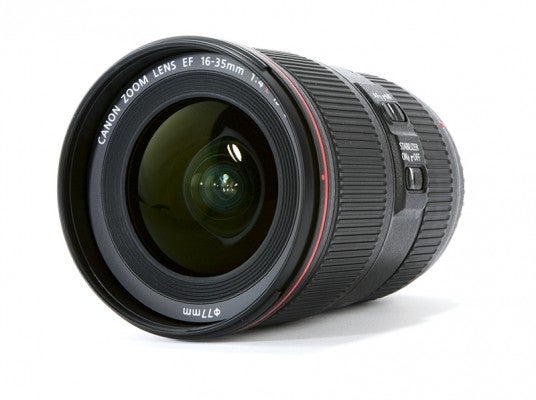Good extreme wideangle zoom lenses for full-frame cameras are not easy to find. Damien Demolder tests Canon’s latest to see if it is up to the job
Canon EF 16-35mm f/4L IS USM review
Canon EF 16-35mm f/4L IS USM review – Introduction
You could forgive most photographers for thinking that a 16-35mm lens would be intended for less-than-full-frame cameras. After all, a focal range such as this would provide a sensible, if slightly odd, 25-56mm on an EOS EF-S APS-C body. The lens on test here, though, is not designed for APS-C bodies, but is what Canon calls an ultra-wide zoom for full-frame cameras. ‘Ultra’ is something of an overused word. I think it is more accurate to say this is an ‘extremely wideangled’ lens. With lenses such as these, we have come to expect a fisheye design, with associated heavily barrelled images, but in this case, Canon assures us that it has provided rectilinear drawing across the frame – so buildings will appear as rectangles, rather than bulging in the middle.
Canon EF 16-35mm f/4L IS USM review – Features
This isn’t the first Canon EF full-frame lens to provide viewing angles of 108°-63°, as the EF 16-35mm f/2.8 L II USM has been around for several years. The new lens is, however, the first to feature Canon’s IS system. Image stabilisation is considered to be less of a priority for wideangles than telephoto lenses, but camera shake is only less noticeable in a wideangle – not non-existent, as the same laws of physics and focal length remain. Canon claims this version of IS gives us the ability to handhold a lens while using a shutter speed 4 stops longer than we should expect. In theory, it should be possible to obtain sharp images with this model at speeds as long as 1sec without the use of a tripod. More realistically, if we assume that the ‘safe’ shutter speed is 1/60sec, this lens’s 4-stop advantage would allow us to shoot handheld at 1⁄2sec.
This model includes Canon’s Ultra Sonic Motor (USM), with the aim of providing near-silent and extremely fast autofocus. This should be of great benefit when shooting moving subjects as they approach the camera, as relative distance changes are dramatic and harder to track.
The lens is constructed of 16 elements in 12 groups, with UD (ultra-low dispersion) glasses used in two elements to tackle chromatic fringing and the blur that occurs when wavelengths focus at different depths. Elements are treated on both faces with Super Spectra coating to reduce internal reflections – a particular problem in wideangles – and Canon has used fluorine coating on the exterior faces of the front and rear elements to discourage water and dust.
Canon is proud of its nine-bladed aperture, which, it claims, produces the roundness of iris required for attractive out-of-focus highlights, or bokeh. However, one wonders just how much of a scene it will be possible to render out of focus with an f/4 lens of such focal lengths as these.





